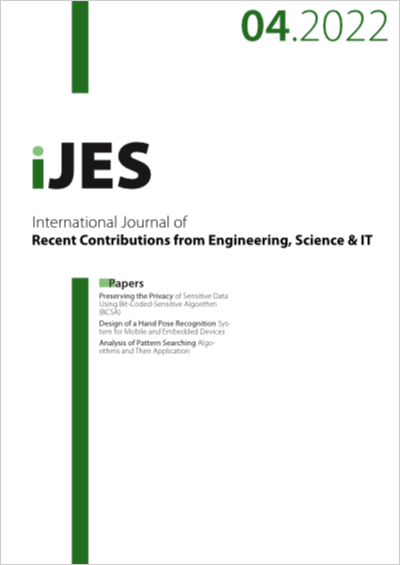Design of a Hand Pose Recognition System for Mobile and Embedded Devices
DOI:
https://doi.org/10.3991/ijes.v10i04.35163Keywords:
android , HOG , SVM, gesture detection, run speedAbstract
Today, smart devices such smart watches and smart cell phones are becoming ever-present in all fields that influence the quality of life of the modern people. These on-board systems have revolutionized the behavior of human beings and especially their way of communicating. In this context and to improve the experience of using these devices, we aim to develop a system that recognizes hand poses in the air by a smart device. In this work, the system is based on Histogram of Oriented Gradient (HOG) features and Support Vector Machine (SVM) classifier. The impact of using HOG and SVM on mobile devices is studied. To carry out this study, we used an improved version of the "NUS I" dataset and obtained a recognition rate of approximately 94%. In addition, we conducted run speed experiments on various mobile devices to study the impact of this task on this embedded platform. The main contribution of this work is to test the impact of using the HOG descriptor and the SVM classifier in terms of recognition rate and execution time on low-end smartphones.Today, smart devices such smart watches and smart cell phones are becoming ever-present in all fields that influence the quality of life of the modern people. These on-board systems have revolutionized the behavior of human beings and especially their way of communicating. In this context and to improve the experience of using these devices, we aim to develop a system that recognizes hand poses in the air by a smart device. In this work, the system is based on Histogram of Oriented Gradient (HOG) features and Support Vector Machine (SVM) classifier. The impact of using HOG and SVM on mobile devices is studied. To carry out this study, we used an improved version of the "NUS I" dataset and obtained a recognition rate of approximately 94%. In addition, we conducted run speed experiments on various mobile devices to study the impact of this task on this embedded platform. The main contribution of this work is to test the impact of using the HOG descriptor and the SVM classifier in terms of recognition rate and execution time on low-end smartphones.
Downloads
Published
How to Cite
Issue
Section
License
Copyright (c) 2022 Houssem Lahiani, Mahmoud Neji

This work is licensed under a Creative Commons Attribution 4.0 International License.
The submitting author warrants that the submission is original and that she/he is the author of the submission together with the named co-authors; to the extend the submission incorporates text passages, figures, data or other material from the work of others, the submitting author has obtained any necessary permission.
Articles in this journal are published under the Creative Commons Attribution Licence (CC-BY What does this mean?). This is to get more legal certainty about what readers can do with published articles, and thus a wider dissemination and archiving, which in turn makes publishing with this journal more valuable for you, the authors.
By submitting an article the author grants to this journal the non-exclusive right to publish it. The author retains the copyright and the publishing rights for his article without any restrictions.
This journal has been awarded the SPARC Europe Seal for Open Access Journals (What's this?)


